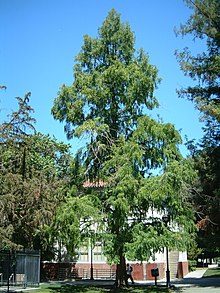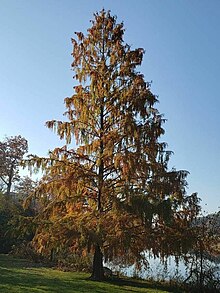Metasequoia
| Metasequoia Temporal range:
| |
|---|---|

| |
| Scientific classification | |
| Kingdom: | Plantae |
| Clade: | Tracheophytes |
| Clade: | Gymnospermae |
| Division: | Pinophyta |
| Class: | Pinopsida |
| Order: | Cupressales |
| Family: | Cupressaceae |
| Subfamily: | Sequoioideae |
| Genus: | Metasequoia Hu&Cheng |
| Type species | |
| Metasequoia glyptostroboides Hu & Cheng
| |
| Species | |
Metasequoia,ordawn redwood,is a genus of fast-growingconiferoustrees, one of three species ofconifersknown as redwoods. The living speciesMetasequoia glyptostroboidesis native toLichuancounty inHubeiprovince,China.Although the shortest of theredwoods,it grows to at least 165 feet (50 meters) in height. Local villagers refer to the original tree from which most others derive asShuǐshān( thủy sam ), or "water fir", which is part of a local shrine. Since its rediscovery in 1944, the dawn redwood has become a popular ornamental, with examples found in various parks in a variety of countries.
Together withSequoia sempervirens(coast redwood) andSequoiadendron giganteum(giant sequoia) ofCalifornia,Metasequoiais classified in theCupressaceaesubfamilySequoioideae.M. glyptostroboidesis the only living species in its genus, but threefossilspecies are known. Sequoioideae and several other genera have been transferred from the former familyTaxodiaceaeto Cupressaceae based on DNA analysis.[1]
Paleontology[edit]
Metasequoiaredwood fossils are known from many areas in theNorthern Hemisphere;more than 20 fossil species have been named (some were even identified as the genusSequoia), but are considered as just three species,M. foxii,M. milleri,andM. occidentalis.[2]Fossils are known from theCenomanianonwards. During thePaleoceneandEocene,extensive forests ofMetasequoiaoccurred as far north asStrathcona FiordonEllesmere Islandand sites onAxel Heiberg Island(northernCanada) at around80° Nlatitude.[3]Metasequoiawas likelydeciduousby this time. Given that the high latitudes in this period were warm and tropical, it is hypothesized that the deciduous trait evolved in response to the unusual light availability patterns, not to major seasonal variations in temperature.[4]During three months in the summer, the sun would shine continuously, while three months of the winter would be complete darkness. It is also hypothesized that the change fromevergreento deciduous trait occurred before colonizing the high latitudes and was the reasonMetasequoiawas dominant in the north.[5]
Large petrified trunks and stumps of the extinctMetasequoia occidentalis(sometimes identified asSequoia occidentalis) also make up the major portion of Tertiary fossil plant material in the badlands of westernNorth Dakota.[citation needed]
The trees are well known from lateCretaceoustoMiocenestrata, but no fossils are known after that. Before its discovery, the taxon was believed to have become extinct during the Miocene; when it was discoveredextant,it was heralded as a "living fossil".
Appearance[edit]

The bark and foliage are similar toSequoia,butMetasequoiaisdeciduouslikeTaxodium distichum(bald cypress), and, similarly, older specimens form wide buttresses on the lower trunk. It is a fast-growing tree to 130–150 feet (40–45 m) tall and 6 feet (2 m) in trunk diameter in cultivation so far (with the potential to grow even higher).[citation needed]
The leaves are opposite, 0.4–1.25 inches (1–3 cm.) long, and bright fresh green, turning foxy red-brown in fall. Thepollencones are 0.25 inch (6 mm) long, produced on long spikes in early spring; they are only produced on trees growing in regions with hot summers. Theconesare globose to ovoid, 0.6–1.0 inches (1.5–2.5 cm.) in diameter with 16–28 scales, arranged in opposite pairs in four rows, each pair at right angles to the adjacent pair; they mature in about 8–9 months after pollination.[citation needed]
Metasequoiahas experienced morphological stasis for the past 65 million years: the modernMetasequoia glyptostroboidesappears identical to its lateCretaceousancestors.[6]
History[edit]

The fossil of this genus was discovered byShigeru Mikiin 1939. In 1941, Miki published the description of the fossil plant which he gave the name "Metasequoia". In the winter of the same year, a Chinese botanist Toh Gan ( càn đạc ) discovered an unusual big tree in Modaoxi ( ma đao khê; presently, Moudao ( mưu đạo ), inLichuan County,Hubei).[7]The locals called this tree shui-sha ( thủy sa ). Because it was winter, the tree already lost all its leaves, so no specimens were collected by Mr. Gan. In 1942, another botanist, Mr. Zhan Wang ( vương chiến ) visited Modaoxi and collected living specimens. Mr. Wang believed this tree belonged to a known speciesGlyptostrobus pensilis( thủy tùng ) and filed the specimens away. In 1945, Mr. Wang showed the specimens to botanistWan Chun Cheng( trịnh vạn quân ). Mr. Cheng determined that the tree did not belong toGlyptostrobus pensilis,but was a new species. Mr. Cheng then sent a specimen to prominent botanistHu Xiansu,the director ofFan Memorial Institute of Biology.Hu, despite the chaos ofwar between China and Japan,was still keeping track of international botanic literature. Hu recognized the living specimen was of the same genus of Miki's fossil genus ''Metasequoia''. After more study, Hu and Cheng published the new speciesMetasequoia glyptostroboides(Hu et Cheng) in May 1948 in the Bulletin of Fan Memorial Institute of Biology. The discovery of a "living fossil" instantly attracted attention from botanists around the world. It was widely regarded as "the greatest discovery of botany in 20th century". In 1948, theArnold ArboretumofHarvard University,through the help of Hu and Cheng, funded an expedition by Chinese collectors to collect seeds. Soon after, seeds were distributed to various universities and arboreta worldwide for growth trials.
Presently, a number of naturalMetasequoiapopulations exist in the hills and wetlands of Hubei's Lichuan County. Most of them are small, with fewer than 30 trees each; however, the largest of them, in Xiaohe Valley, is estimated to consist of around 5,400 trees.[7]A few trees are also said to exist in neighboringHunanProvince.[7]
Metasequoiain gardens, parks and streets[edit]

Dawn redwoods are fast-growing trees. They sometimes grow too large in smaller gardens under favorable conditions, but they can be a good choice for a wide range of larger gardens and parks. Although they live in wet sites in their native habitat they will also tolerate dry soils.[8]Unlike most conifers, their deciduous habit means they do not cast much shade in winter. They are grown as street trees in London and elsewhere.
Strawberry Fieldsis a landscaped section in New York City's Central Park dedicated to Beatle John Lennon. At the northern end of the lawns are three dawn redwood trees. The trees drop their needles each fall and regrow them each spring, a symbol of eternal renewal. The trees are expected to reach a height of 36 meters (118 ft), making them visible from great distances.[citation needed]
In New York City on East Houston Street at Liz Christy Community Garden, there is a prominent dawn redwood tree. The tree is said to have been planted by Liz Christy herself in the 1970s.[9]
References[edit]
- ^Gadek, Paul A.; Alpers, Deryn L.; Heslewood, Margaret M.; Quinn, Christopher J. (2000)."Relationships within Cupressaceaesensu lato:a combined morphological and molecular approach ".American Journal of Botany.87(7): 1044–1057.doi:10.2307/2657004.JSTOR2657004.PMID10898782.
- ^Farjon, A. (2005).Monograph of Cupressaceae andSciadopitys.Royal Botanic Gardens, Kew.ISBN1-84246-068-4.
- ^Williams, Christopher J.; Johnson, Arthur H.; LePage, Ben A.; Vann, David R.; Sweda, Tatsuo (2003)."Reconstruction of TertiaryMetasequoiaforests. II. Structure, biomass, and productivity of Eocene floodplain forests in the Canadian Arctic "(PDF).Paleobiology.29(2): 271–292.doi:10.1666/0094-8373(2003)029<0271:ROTMFI>2.0.CO;2.S2CID131497232.
- ^Chaney, Ralph W. (1948)."The bearing of the livingMetasequoiaon problems of Tertiary paleobotany ".Proceedings of the National Academy of Sciences.34(11): 503–515.Bibcode:1948PNAS...34..503C.doi:10.1073/pnas.34.11.503.JSTOR88221.PMC1079159.PMID16588827.
- ^Richard Jagels & Maria A. Equiza (2005).Competitive advantages ofMetasequoiain warm high latitudes.pp. 335–349.InLePageet al(2005).
- ^Ben A. LePage, Hong Yang & Midori Matsumoto (2005).The evolution and biogeographic history ofMetasequoia.pp. 3–115.InLePageet al(2005).
- ^abcLanglois, Gaytha A. (2005).A conservation plan forMetasequoiain China.Springer. pp. 367–418.ISBN9781402026317.InLePageet al(2005).
- ^Hibberd, B. G., ed. (1989).Urban Forestry Practice, Forestry Commission Handbook 5.p. 61.InHibberd (1989).
- ^Young, Michelle (2017-06-05)."There's a Redwood Tree on Houston Street in NYC".Untapped New York.Retrieved2022-10-22.
Further reading[edit]
- Zican He; Jianqiang Li; Qing Cai; Xiaodong Li; Hongwen Huang (2004). "Cytogenetic studies onMetasequoia glyptostroboides,a living fossil species ".Genetica.122(3): 269–276.doi:10.1007/s10709-004-0926-x.PMID15609550.S2CID19447950.
- Proceedings of the Second International Symposium onMetasequoiaand Associated Plants, August 6–10, 2006, Metasequoia: Back from the Brink? An Update. Edited by Hong Yang and Leo J. Hickey. Bulletin of thePeabody Museum of Natural History,Volume 48, Issue 2 31 October 2007, pp. 179–426.[1]
- The Reports of the Third International Metasequoia Symposium, August 3 to 8, 2010, Osaka, Japan[2]
- A. Hope Jahren& Leonel Silveira Lobo Sternberg (2003)."Humidity estimate for the middle Eocene Arctic rain forest"(PDF).Geology.31(5): 463–466.Bibcode:2003Geo....31..463J.doi:10.1130/0091-7613(2003)031<0463:HEFTME>2.0.CO;2.Archived fromthe original(PDF)on 2007-09-27.Retrieved2019-05-29.
- Christopher J. Williams; Ben A. LePage; David R. Vann; Takeshi Tange; Hiroyuki Ikeda; Makoto Ando; Tomoko Kusakabe; Hayato Tsuzuki; Tatsuo Sweda (2003)."Structure, allometry, and biomass of plantationMetasequoia glyptostroboidesin Japan "(PDF).Forest Ecology and Management.180(1–3): 287–301.doi:10.1016/S0378-1127(02)00567-4.Archived fromthe original(PDF)on 2008-04-11.
- Ben A. LePage; Christopher James Williams; Hong Yang, eds. (2005).The Geobiology and Ecology ofMetasequoia.Topics in geobiology. Vol. 22.Dordrecht,the Netherlands:Springer.ISBN1-4020-2631-5.
- B.G. Hibberd, ed. (1989).Urban Forestry Practice, Forestry Commission Handbook 5(PDF).London:Her Majesty's Stationery Office.ISBN0-11-710273-3.[dead link]
External links[edit]
- The metasequoia organisation
- Giant redwoods in the U.K.
- "Metasequoia glyptostroboides".Integrated Taxonomic Information System.
- D.A. Hänks."Crescent Ridge Dawn Redwoods Preserve".
- Hu, H. H.&Cheng, W. C.1948.Bulletin of the Fan Memorial Institute of Biology,new series 1: 154.
- "Feb".World Checklist of Selected Plant Families(WCSP).Royal Botanic Gardens, Kew.
